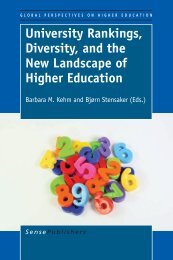Rupturing Concepts of Disability and Inclusion
Rupturing Concepts of Disability and Inclusion
Rupturing Concepts of Disability and Inclusion
You also want an ePaper? Increase the reach of your titles
YUMPU automatically turns print PDFs into web optimized ePapers that Google loves.
CHAPTER 2<br />
<strong>and</strong> dominance be contested, <strong>and</strong> the vapidity <strong>of</strong> these approaches be exposed.<br />
Such an approach is not indefensible. It is part <strong>of</strong> a contemporary trend <strong>of</strong><br />
methodological shifts which challenge established research paradigms. For<br />
example, Andy Knight writes in relation to multilateralism that:<br />
28<br />
... [T]he intellectual approach to mulitlateralism is undergoing a shift from<br />
the traditional (<strong>and</strong> problem-solving) rationalist to a reflectivist (<strong>and</strong> critical)<br />
scholarship.<br />
Using methods <strong>of</strong> enquiry that are hermeneutic, dialectic <strong>and</strong> reflectivist, in<br />
contrast to the positivist <strong>and</strong> problem-solving approaches <strong>of</strong> rationalist<br />
researchers. 116<br />
Therefore, the emerging, yet constraining aporia between traditional applied ethics<br />
<strong>and</strong> the disability context is not only confronted, but comm<strong>and</strong>s a creative<br />
response. It will become apparent in later chapters that this aporia is not readily<br />
recognised within the established traditional paradigms <strong>of</strong> applied ethics. A fuller<br />
conceptualisation <strong>of</strong> the ethical significance <strong>of</strong> inclusion is evoked.<br />
2.5.2 Creating A Methodological Metaphor<br />
A challenge emerges as to how a researcher can best work with seemingly disjointed<br />
fragments to construct an adequate explanation <strong>of</strong> the ethical significance <strong>of</strong> the<br />
notion <strong>of</strong> inclusion. I have chosen to use metaphor to meet such a challenge. Johnson<br />
argues, “The way we frame <strong>and</strong> categorise a given situation determines how we<br />
reason about it, <strong>and</strong> how we frame it depends on which metaphorical concepts we<br />
are using.” 117<br />
imaginative cognition;” <strong>and</strong> opens up new dimensions <strong>of</strong> our moral underst<strong>and</strong>ing. 118<br />
Gareth Morgan also claims that metaphor is <strong>of</strong>ten used as a device “for embellishing<br />
discourse”; however, he continues, its real significance is much greater, for metaphor<br />
“implies a way <strong>of</strong> thinking <strong>and</strong> a way <strong>of</strong> seeing that pervade how we underst<strong>and</strong> our<br />
world generally.” 119 Feminist theologian, Sally McFague states, “Metaphor is a<br />
strategy <strong>of</strong> desperation, not decoration; it is an attempt to say something about the<br />
unfamiliar in terms <strong>of</strong> the familiar, an attempt to talk about what we do not know in<br />
terms <strong>of</strong> what we do know.” 120 Elsewhere she comments that metaphorical thinking<br />
is “intrinsically perspectival”; for whilst we can derive similarities, we also<br />
appears to belong to one particular context, but is used in another, as a semantic<br />
tool to make visible certain traits that have remained invisible. 122<br />
Lincoln <strong>and</strong> Denzin promote the methodological metaphor <strong>of</strong> the researcher as a<br />
bricoleur, who not only cobbles together a new piece from used or historical<br />
material, but who invents, like an artist, a new future through creative <strong>and</strong><br />
innovative uses <strong>of</strong> material. 123 He writes that metaphor “is one <strong>of</strong> our principal mechanisms <strong>of</strong><br />
121<br />
acknowledge dissimilarities. A metaphor, then, is a word or a phrase which<br />
This is a similar metaphor to that evoked by critical<br />
theorist, Levi-Strauss, in the 1960s. John O’Neill explains:<br />
The bricoleur … moves into a neighbouring craft whenever the need to<br />
improvise arises, a need able to be seen within the materials at h<strong>and</strong> although














